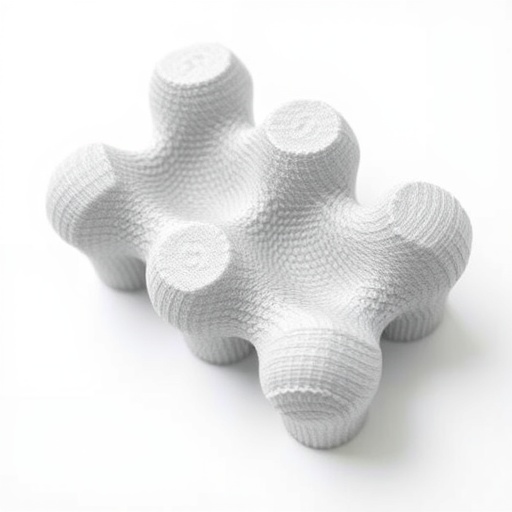Researchers at City University of Hong Kong (CityU HK) have made significant strides in the field of biomedical engineering with the development of innovative artificial bone scaffolds made from nickel-titanium (NiTi) alloys. These scaffolds exhibit remarkable superelastic properties, showing deformation recovery capabilities between 6% to 7%. This performance exceeds that of natural bone, which typically recovers between 2% and 4%, and conventional metallic scaffolds, which register less than 1%. The implications of these advancements are profound, especially in the realm of bone implants, where the ability to tailor mechanical properties is crucial for effective healing and integration with natural tissue.
Traditionally, artificial bone scaffolds have faced limitations in mimicking the complex mechanical properties of natural bone. Researchers have identified that scaffolds must closely replicate these characteristics to adequately support new bone growth. Professor Jian Lu, the leading author of the study, highlights the necessity for scaffolds to provide sufficient deformation recovery along with adjustable strength, modulus, and permeability. These attributes are essential to ensure compatibility with diverse implantation sites and to promote optimal biological responses during healing.
The global market for bone implants has witnessed a dramatic increase, projected to reach $64.27 billion by 2030. This growth is fueled by an aging population and the rising incidence of bone-related conditions, including osteoporosis and other degenerative diseases. As demand surges, the challenge remains to develop scaffolds that not only support mechanical strength but also facilitate biological interactions that lead to successful bone regeneration. Conventional metallic scaffolds have struggled to meet these expectations, often falling short in terms of flexibility and adaptability as compared to natural bone.
The research team at CityU HK has leveraged laser powder bed fusion (LPBF), an advanced 3D printing technology, to fabricate NiTi scaffolds. This cutting-edge method presents a solution to the challenges posed by traditional manufacturing processes, which often cannot achieve the desired complex topological structures required for effective scaffolding. The team’s innovative approach involved the synergistic optimization of both the microstructure and macrostructure of the scaffolds, allowing for greater control over mechanical properties and mass transfer capabilities.
By designing scaffolds with hierarchical microstructures and gyroid-sheet topologies, the researchers have significantly enhanced the reversible martensitic phase transformation within the materials. This enhancement directly contributes to improved superelasticity, making the scaffolds more resilient and better suited for the dynamic environment of the human body. The taxonomy of properties achieved through this technique enables customization to meet the specific needs of various implantation scenarios, ultimately leading to better clinical outcomes.
The study, recently published in the International Journal of Extreme Manufacturing, employs advanced analytical techniques to detail the attributes of the newly engineered NiTi scaffolds. The results suggest a strong correlation between the volume fraction, unit cell size, and the resulting mechanical and mass transport properties of the scaffolds. Such tailoring capabilities provide a unique advantage that could revolutionize how scaffolds are utilized in clinical settings, offering personalized solutions to patients undergoing bone repair.
Future research directions outlined by the authors emphasize the importance of exploring biocompatibility and long-term durability of the developed scaffolds. Investigating factors like fatigue resistance and corrosion in physiological environments will be critical as the scaffolds transition from laboratory to clinical practice. An understanding of these aspects will provide deeper insights into the scaffolding behavior, potentially leading to prolonged functionality and effectiveness in vivo.
As the scientific community continues to explore the intersections of material science and biomedical engineering, this research stands out for its practical implications. The combination of nickel-titanium’s inherent superelasticity with the customizable capabilities of additive manufacturing could set a new benchmark in the design and application of scaffolds for bone regeneration. The prospect of producing patient-specific implants that adapt not only functionally but also biologically resonates well with ongoing shifts toward personalized medicine.
In conclusion, the introduction of superelastic NiTi scaffolds represents a significant breakthrough in the quest to develop more effective artificial bone implants. The advancements in 3D printing technology may pave the way for a new era in regenerative medicine and tissue engineering, enhancing the quality of life for those dealing with bone-related ailments. As research progresses, the potential impact of these innovations on patient care and treatment outcomes could be truly transformative.
Subject of Research: Development of superelastic NiTi scaffolds for artificial bone applications
Article Title: Superelastic NiTi scaffolds with extensively tunable mechanical and mass transfer properties
News Publication Date: 25-Jul-2025
Web References: International Journal of Extreme Manufacturing
References: 10.1088/2631-7990/adf01e
Image Credits: By Shiyu Zhong, Lei Zhang, Ying Li, Wanying Wang, Gan Li, Yulun Luo, Dingfei Zhang and Jian Lu*
Keywords
Additive manufacturing, Biomedical engineering, Biomaterials, NiTi alloys, Superelastic scaffolds, Tissue engineering, Regenerative medicine.




